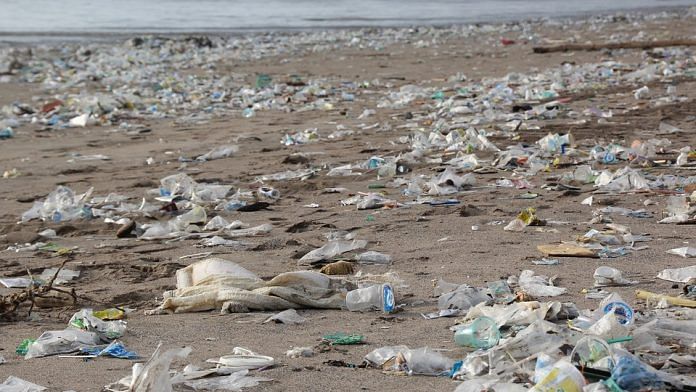We all think we know what single-use plastic looks like. People make great efforts to avoid, re-use or recycle it. And now, in addition to the bottles, boxes and bags, there is an ocean of COVID-19 PPE to contend with. This is the problem as we understand it.
Yet amongst the swarms of facemask jellyfish another plastic pollutant floats, not captured by the camera lens.
It is a type of single-use plastic you probably use every day, but never see. As tiny as a grain of fine sand, these hidden microplastics cannot be collected and recycled. But, little by little, they’re adding up to a huge problem.
The ‘microcapsule’, as it is known, is a form of microplastic. Many millions of tonnes of microcapsules are manufactured and added to the ingredients of homecare, laundry products, skincare and cosmetics every year. Barely visible to the naked eye, suspended in liquids and lotions, these hidden microplastics preserve and release active ingredients, such as droplets of perfume in fabric softeners and detergents.
The science of scent is clever stuff. Our brains tell us white clothes look whiter when they smell a certain way. Brands have signature fragrances and can charge a premium for them. But behind these benefits, for consumer and industry alike, are microcapsules.
These tiny spheres provide the big hit of ‘just-washed’ fragrance we love on our clothes by releasing scent at key moments. The perfume on the breeze as your laundry dries on the line. The fresh feel when you pull a top over your head. The scent still going strong at the end of a long day. It is the plastic in your product that makes this possible.
Based on washing machine usage data from the Energy Savings Trust, we estimate the average UK family puts 55 million microcapsules a week in their laundry cycle. A volume most – myself included – find very hard to comprehend. Even with conservative estimates, that means each household washes nearly 14 million tiny particles of plastic down the drain every seven days. In Europe alone, more than 17,000 tonnes of microplastics are added to detergents and other cleaning products each year.
Many of these microplastics make their way into rivers, soil and the ocean where they persist for decades, harming aquatic life and even ending up in the food chain and tap water. Their presence has been confirmed in everything from Antarctic krill to Australian sardines, Sicilian carrots to German beer. Their impact on our health is less well understood.
Right now, washing clothes more often is one way we can protect ourselves from the pandemic, and is vital for some professions. But more laundry means more product, more microcapsules, and more pollution, and so the problem escalates.
The issue has not passed completely under the radar. Organisations like the Plastic Soup Foundation have been lobbying against plastic ingredients like these for some time. We need action now, and across the globe, to protect the planet.
If we cannot collect and recycle these microplastics, and governments have not yet banned them, what to do?
Here at Xampla, a University of Cambridge spin-out, we are developing a solution to provide all the benefits brands and consumers want from a microcapsule, without the plastic pollution.
Our science has been inspired by one of the most impressive material producers of the natural world. For 380 million years, one creature has been creating a strong and flexible substance. The spider works with protein, harnessing the amino acids’ natural ability to self-assemble. It simply uses protein and energy to create spider silk – a high performance material that, weight for weight, is significantly stronger than steel.
We have discovered how to use a similar, efficient process to create a plastic-like material from harmless plant protein. This material – found in high concentrations in legumes like peas and soy, but also in rapeseed and even potatoes – is both abundant and renewable. Which makes it a much more sustainable feedstock than petrochemicals. Or spider silk.
Ours is not the only natural, commercial alternative to single-use plastic. But it is the first made from plant protein rather than polysaccharides like seaweed and algae. And as it does not rely on the addition of harsh solvents for its strength and stability, it decomposes naturally, fully and quickly when it is disposed of – which makes it perfect for washing down the drain.
The EU has identified specific categories of microplastics for the proposed ECHA ban on Intentionallly Added Microplastics, currently under consultation. We offer a solution to those industries affected, and estimate that we could substitute up to 100,000 tonnes of microplastics within 10 years of the ban’s implementation.
COVID-19 has inevitably impacted on companies’ and governments’ plans to transition to a post-oil planet. Priorities have shifted to the short-term, and businesses understandably argue for more time to make changes. The focus remains on high profile, visible plastic pollution. But there are solutions for hidden microplastics such as microcapsules, that companies can implement today without complex structural or behavioural change.
Xampla’s materials are one of a handful around the world that represent the next generation of bio-based materials, and a practical scaleable route to make the transition. This is what ‘building back better’ looks like in practice, and how we can deliver our long-term objectives despite the short-term pressures. We can replace polluting single-use plastics, including the ones that we cannot see.
Also read: Delhi to Vijayawada, India has started dumping Covid-19 infected waste in public places
This article was first published in World Economic Forum.



